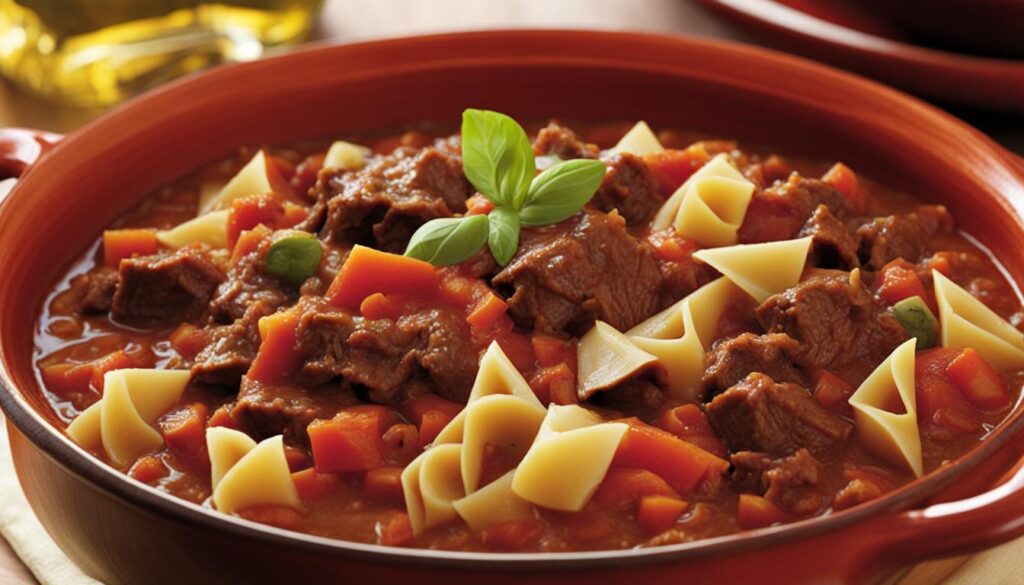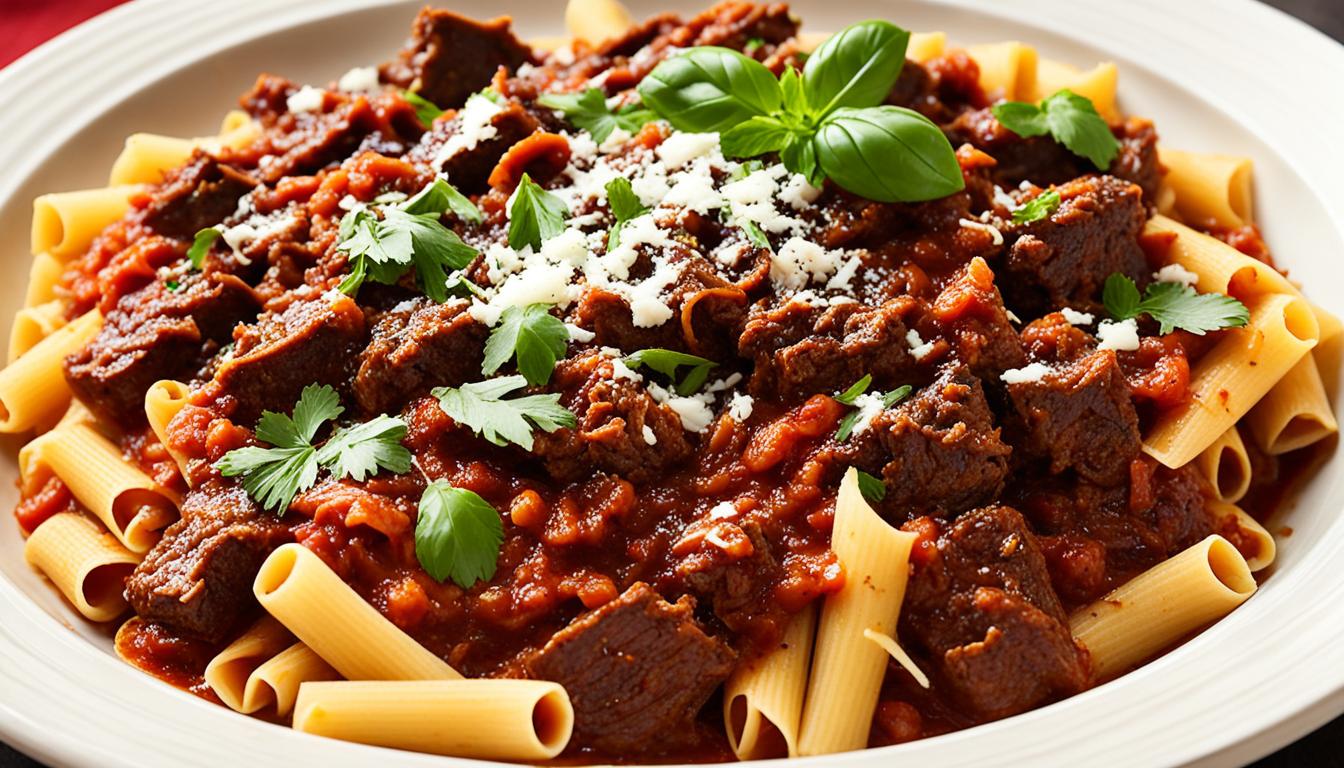When it comes to classic Italian recipes, few dishes can rival the rich flavors and traditional essence of Pasta alla Genovese. This Neapolitan Beef Ragu is a testament to the mastery of Italian cuisine, showcasing the beloved combination of slow-cooked beef and onions that creates a heavenly sauce. But is it truly the ultimate classic Italian recipe?
Join us as we delve into the origins, techniques, and secrets behind this iconic dish. We’ll explore the authentic flavors of traditional Italian cuisine and reveal tips for making the perfect Pasta alla Genovese. By the end, you’ll have all the knowledge and inspiration you need to cook up a taste of Italy in your own kitchen.
The Origins of Pasta alla Genovese
The origins of Pasta alla Genovese can be traced back to Naples in the 15th century. Despite its name, this dish is not from Genoa, but rather it is a Neapolitan specialty. It is believed that the recipe was created by a Neapolitan chef with the nickname “Genovese.” Over time, the dish became popular in Naples and is now considered a traditional regional Italian dish. The slow cooking process of the beef and onions creates a flavorful sauce that is beloved by locals and visitors alike.
The Technique Behind Neapolitan Beef Ragu
Neapolitan Beef Ragu is a beloved dish in traditional Italian cuisine, known for its rich flavors and tender meat. The key to mastering this authentic Italian pasta dish lies in the technique of slow cooking.
To prepare Neapolitan Beef Ragu, start by braising the beef in a pot with a generous amount of onions. Allow the meat and onions to simmer together for several hours, allowing the flavors to develop and the meat to become meltingly tender.
This slow cooking method is essential as it releases the natural moisture of the onions, creating a flavorful braising liquid that infuses the beef with savory goodness. No additional stock is necessary, as the onions provide all the moisture needed to braise the beef to perfection.
To enhance the flavors and provide a balanced acidity, a small amount of tomato paste and cherry tomatoes are added to the sauce. These ingredients complement the richness of the beef and onions, resulting in a harmonious sauce.
Once the beef is thoroughly tender, it is cut into bite-size pieces. Some of the meat melds into the sauce, creating a luscious and textured ragu, while the remaining pieces maintain their integrity, offering delightful morsels to savor.
Neapolitan Beef Ragu is best enjoyed tossed with your favorite authentic Italian pasta, such as tagliatelle or pappardelle. The pasta perfectly absorbs the flavors of the ragu, creating a delectable and satisfying dish.

Tip: The slow cooking process is key to attaining the tender and flavorful Neapolitan Beef Ragu. Allow the beef and onions to simmer for several hours to achieve the best results.
The Ingredients and Techniques of Genovese Ragu
To make a traditional Genovese Ragu, you will need a tough cut of beef, such as chuck roast, which is well-suited for long, slow cooking. The beef is seasoned with salt and pepper before being cooked in a Dutch oven with a mixture of onions, carrots, and celery. The onions, in particular, play a crucial role in this dish, providing both flavor and moisture to the sauce. The sauce is simmered for several hours until the beef is tender and the flavors have melded together. The pasta is cooked separately and then tossed with the ragu before serving. This allows the pasta to absorb the flavors of the sauce, creating a cohesive and delicious dish.
Ingredients for Genovese Ragu:
- Tough cut of beef, such as chuck roast
- Salt and pepper for seasoning
- Onions
- Carrots
- Celery
Techniques for Making Genovese Ragu:
- Season the beef with salt and pepper.
- Cook the beef in a Dutch oven with onions, carrots, and celery.
- Simmer the sauce for several hours until the beef is tender and the flavors have melded together.
- Cook the pasta separately.
- Toss the cooked pasta with the ragu before serving.
Preparation Steps:
- Begin by seasoning the beef with salt and pepper.
- In a Dutch oven, cook the beef with onions, carrots, and celery over low heat.
- Simmer the sauce for several hours until the beef becomes tender and the flavors meld together.
- Cook the pasta separately according to the package instructions.
- Once both the ragu and pasta are ready, toss them together to allow the pasta to absorb the rich flavors of the sauce.
Pro Tip:
For an extra burst of flavor, add a splash of red wine to the ragu while it cooks. The acidity of the wine will help balance the richness of the dish.
Now that you have the ingredients and techniques to make a delicious Genovese Ragu, you can impress your family and friends with an authentic Italian pasta dish that showcases the flavors of regional Italian cuisine. The slow-cooked beef and the melding of flavors create a rich and hearty sauce that pairs perfectly with your favorite pasta.
Tips for Making the Perfect Pasta alla Genovese
Making the perfect Pasta alla Genovese requires attention to detail and a touch of Italian finesse. Here are some tips to help you create an authentic and delicious dish:
1. Choose the right cut of beef: Opt for a full-flavored and collagen-rich cut like chuck roast. Trim and cut it into manageable pieces for slow cooking. This will ensure that the beef becomes tender and infuses the sauce with rich flavors.
2. Slow cook the sauce: Simmer the beef and onions in a Dutch oven for several hours to allow the flavors to develop. Stir occasionally to prevent sticking. This slow cooking process will result in a luscious and hearty sauce that complements the pasta perfectly.
3. Cut the beef into bite-size pieces: Once the beef is tender, cut it into smaller, bite-size pieces before adding it back to the sauce. This will create a balance of texture in each mouthful, allowing the flavors to mingle harmoniously.
4. Use the right pasta: Traditional Genovese Ragu is often served with ziti or zitoni pasta. However, you can also opt for rigatoni or penne as delicious alternatives. Cook the pasta al dente to retain its desired texture when tossed with the sauce.
5. Garnish and serve: Before serving, garnish your Pasta alla Genovese with freshly chopped parsley and a generous sprinkle of grated Parmesan cheese. This will add a touch of freshness and enhance the flavors of the dish, giving it that authentic Italian touch.
Follow these tips and indulge in the rich and comforting flavors of this classic Italian recipe. Buon appetito!
